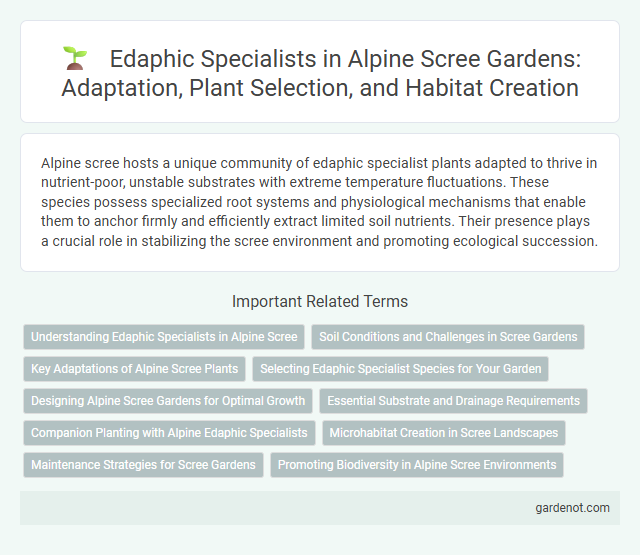Alpine scree hosts a unique community of edaphic specialist plants adapted to thrive in nutrient-poor, unstable substrates with extreme temperature fluctuations. These species possess specialized root systems and physiological mechanisms that enable them to anchor firmly and efficiently extract limited soil nutrients. Their presence plays a crucial role in stabilizing the scree environment and promoting ecological succession.
Understanding Edaphic Specialists in Alpine Scree
Edaphic specialists in alpine scree exhibit unique adaptations to thrive in nutrient-poor, unstable substrates characterized by coarse rocky debris and limited organic matter. These plants possess root structures and physiological mechanisms optimized for efficient nutrient uptake and water retention in harsh, well-drained environments. Understanding the role of edaphic specialists enhances ecological knowledge of alpine scree biodiversity and aids in conservation strategies for these sensitive habitats.
Soil Conditions and Challenges in Scree Gardens
Edaphic specialists studying alpine scree focus on the unique soil conditions characterized by poor nutrient availability, high drainage, and fluctuating moisture levels. These challenging environments require plants to adapt to shallow, unstable soils with low organic matter and extreme temperature variations. Understanding soil texture, pH, and mineral content is crucial for selecting and cultivating suitable species in scree gardens.
Key Adaptations of Alpine Scree Plants
Alpine scree plants exhibit key adaptations such as deep-rooted systems to anchor in unstable, rocky substrates and specialized root morphologies for efficient nutrient absorption in nutrient-poor, edaphically stressful environments. These edaphic specialists demonstrate remarkable tolerance to low soil moisture and extreme temperature fluctuations characteristic of alpine scree habitats. Morphological traits including reduced leaf area and protective trichomes minimize water loss and shield against abrasive winds, optimizing survival on nutrient-scarce alpine scree slopes.
Selecting Edaphic Specialist Species for Your Garden
Selecting edaphic specialist species for your alpine scree garden requires understanding soil composition, drainage, and nutrient availability specific to harsh, rocky environments. Opt for plants like Saxifraga, Silene, and Draba that thrive in well-drained, mineral-rich substrates with low organic matter. These species demonstrate high tolerance to temperature fluctuations and poor soil conditions, ensuring optimal growth and landscape stability.
Designing Alpine Scree Gardens for Optimal Growth
Edaphic specialists prioritize soil composition, drainage, and nutrient balance to replicate natural alpine scree conditions for optimal plant growth. By analyzing pH levels, mineral content, and soil texture, they ensure alpine scree gardens provide the specific substrates that support specialized alpine flora. Proper design incorporates rock placement and microhabitats to emulate natural stress factors essential for edaphic specialists' target species.
Essential Substrate and Drainage Requirements
Edaphic specialists in alpine scree thrive on substrates rich in mineral content and well-drained rocky soils that prevent waterlogging while sustaining essential nutrients. These plants rely on porous, coarse-grained scree that enables rapid drainage, maintaining oxygen availability to root systems crucial for survival in this harsh environment. Optimal drainage combined with substrate mineralogy directly influences root health and nutrient uptake, defining the ecological niche of alpine scree specialists.
Companion Planting with Alpine Edaphic Specialists
Alpine scree landscapes host a unique community of edaphic specialist plants adapted to rocky, nutrient-poor soils, where companion planting promotes mutual growth and resilience. Edaphic specialists such as Saxifraga and Draba species enhance soil stability and nutrient cycling, benefiting neighboring alpine flora through root interactions and microhabitat modifications. Strategic companion planting with these alpine edaphic specialists improves soil retention and creates microclimates that support biodiversity and plant survival in harsh scree environments.
Microhabitat Creation in Scree Landscapes
Edaphic specialists in alpine scree landscapes play a crucial role in microhabitat creation by influencing soil composition, moisture retention, and nutrient cycling within scree microenvironments. These organisms, including specialized lichens, mosses, and root-associated microbes, stabilize soil particles and enhance organic matter accumulation, which supports diverse alpine flora. Through their edaphic activities, these specialists facilitate species colonization and succession, contributing to ecosystem resilience in harsh scree habitats.
Maintenance Strategies for Scree Gardens
Edaphic specialists emphasize the importance of soil composition and drainage when maintaining alpine scree gardens to mimic natural mountain habitats. Regular monitoring of substrate pH and moisture levels supports the health of specialized scree flora, preventing root rot and nutrient imbalances. Implementing strategic layering of gravel and sand enhances aeration and controls erosion, promoting sustainable plant growth in these unique environments.
Promoting Biodiversity in Alpine Scree Environments
Edaphic specialists in alpine scree environments play a crucial role in promoting biodiversity by adapting to the unique soil conditions characterized by poor nutrient availability, high drainage, and extreme temperature fluctuations. These organisms enhance soil stability and nutrient cycling, facilitating the establishment of pioneer plant species and supporting diverse microhabitats. Their ecological functions contribute significantly to sustaining fragile alpine ecosystems and fostering resilience against environmental stressors.
Edaphic specialist Infographic

 gardenot.com
gardenot.com